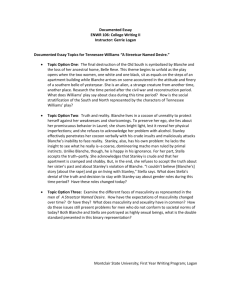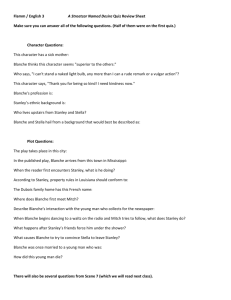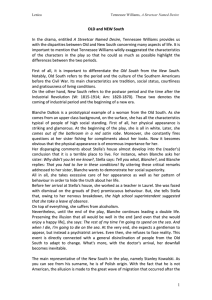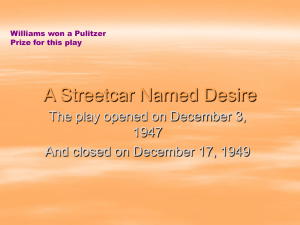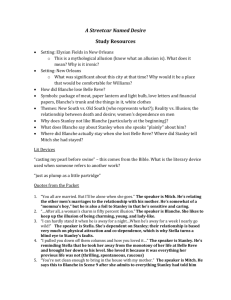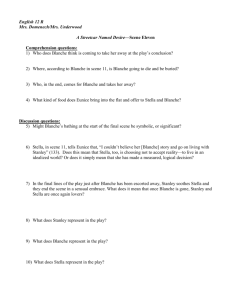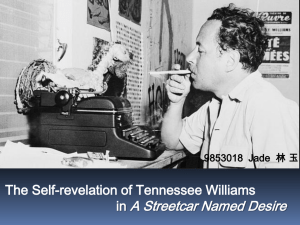Blanche Dubois: A Woman Between Fantasy And Reality
advertisement
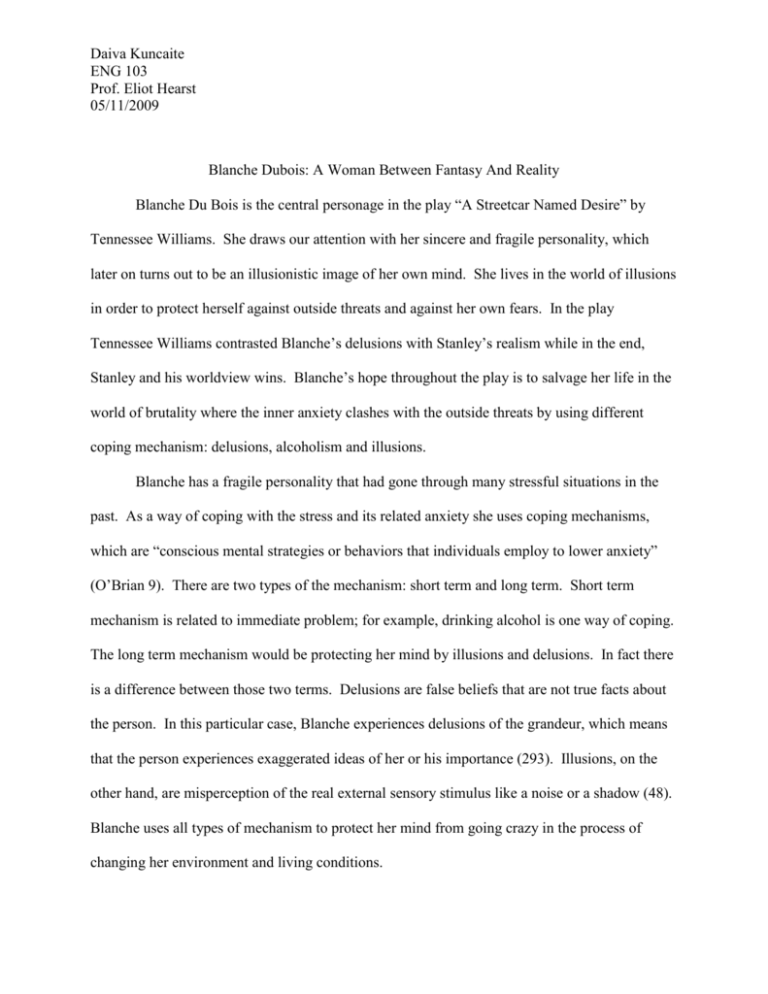
Daiva Kuncaite ENG 103 Prof. Eliot Hearst 05/11/2009 Blanche Dubois: A Woman Between Fantasy And Reality Blanche Du Bois is the central personage in the play “A Streetcar Named Desire” by Tennessee Williams. She draws our attention with her sincere and fragile personality, which later on turns out to be an illusionistic image of her own mind. She lives in the world of illusions in order to protect herself against outside threats and against her own fears. In the play Tennessee Williams contrasted Blanche’s delusions with Stanley’s realism while in the end, Stanley and his worldview wins. Blanche’s hope throughout the play is to salvage her life in the world of brutality where the inner anxiety clashes with the outside threats by using different coping mechanism: delusions, alcoholism and illusions. Blanche has a fragile personality that had gone through many stressful situations in the past. As a way of coping with the stress and its related anxiety she uses coping mechanisms, which are “conscious mental strategies or behaviors that individuals employ to lower anxiety” (O’Brian 9). There are two types of the mechanism: short term and long term. Short term mechanism is related to immediate problem; for example, drinking alcohol is one way of coping. The long term mechanism would be protecting her mind by illusions and delusions. In fact there is a difference between those two terms. Delusions are false beliefs that are not true facts about the person. In this particular case, Blanche experiences delusions of the grandeur, which means that the person experiences exaggerated ideas of her or his importance (293). Illusions, on the other hand, are misperception of the real external sensory stimulus like a noise or a shadow (48). Blanche uses all types of mechanism to protect her mind from going crazy in the process of changing her environment and living conditions. Daiva Kuncaite ENG 103 Prof. Eliot Hearst 05/11/2009 In the beginning of the play Tennessee Williams gives the illusionary plan using the structure of the play, how Blanche can escape from her life. According to the literature critic T. Dace “… Streetcar begins in springtime, a period when Blanche hopes she can salvage her life; progresses through a sweltering summer of explosive passion, and winds down in autumn, when not merely the days but Blanche’s dreams will wane (1). Blanche’s anticipation for new life is seen in her statement to the Eunice. “They told me to take a street- car named Desire, and then transfer to one called Cemeteries and ride six blocks and get off at – Elysian Fields!”(Williams 471). The first part of this statement is talking about the life Blanche was leading at Belle Reve and second part is talking about her present life at Stella and Stanley’s home and a chance to reach desirable salvation (Mood 1). The deaths in the family were bothering her and she expresses this by complaining to her sister: “All of those deaths! The long parade of the graveyard! Father, mother!”(Williams 479). Her life becomes a metaphor for street-car called Cemeteries. However, here she has a chance to change her life by getting off at Elysian Fields which stands for beauty and love. She has that opportunity by creating a loving relationship with Mitch, and “thus, at the end of the sixth scene, the sixth block on her ride of death, Blanche indeed is on the threshold of finding ‘God,’ ‘Elysian Fields,’ loving desire” (Mood 2). She loses her hope at the time Stanley steps in and tells the truth about her shady past to Mitch. Stanley’s realistic outlook wants to protect his friend Mitch from making a wrong decision and hence separates Blanche’s delusions from her lies. For Stanley her life is full of lies which she uses in order to manipulate others. On the other hand, for Blanche, the lies about her life are a created delusion to survive. It is no surprise that, in the scene seven, Stanley’s speech about her life full of lies is interfered five times with her song of the paper moon: “It’s only a paper moon, Just as Daiva Kuncaite ENG 103 Prof. Eliot Hearst 05/11/2009 phony as it can be -/But it wouldn’t be make – believe If you believed in me!”(Williams 531). Phony paper moon refers to the double life she has been leading: one is real and other created by her imagination. Her song sounds like asking Stanley to believe in her mendacity because that’s what makes her happy. After the song she laughs “as if a child were frocking in the tub” (Williams 532). This is an indication that her delusions help her to go back in time to her childhood memories where she felt safe and happy. According to the coping mechanism theory this is one way of reducing stress and fears about an uncertain future. The continuous failure to crate meaningful relationships with other man after the death of her husband, leads her to wander in life until she reaches Stanley and Stella’s home. She attempts to create an intimate relationship with Mitch. According to the critic George Hovis, “Blanche’s involvement with Mitch here is essentially autoerotic; she is interested in the moment only for the possibility of projecting fantasies that seems from her first introduction to Bohemian with her poet husband” (179). She lights the candle and says “We are going to be very Bohemian. We are going to pretend that we are sitting in a little artist’s café on the Left Bank in Paris!” (Williams 523). She seeks to involve Mitch to be a part of her imagination but he seems to feel uncomfortable. Mitch is representing the real world because he talks with her about the domestic things like perspiration and the coat material, whereas Blanche creates the world of illusion in order to compensate for the lack of interest during their date (Hovis 179). Even though Mitch doesn’t fit well in the world she created for him she reaches the point of intimacy by being honest about her first husband and the guilt she endures. For a moment she steps down from the imaginative world and shares the painful moment of her life. Stanley’s interference ruins her plans and yet again she had to retreat in the world of her delusions. Daiva Kuncaite ENG 103 Prof. Eliot Hearst 05/11/2009 Blanche has a fantasy that her relationship with Mitch can work out when in reality she just wants a safe haven for life. She admits to her sister: “I want to be near you, got to be with somebody, I can’t be alone!” (Williams 477). These words show that she is yet again willing to get control of her life and create new relationships. However, she was never in love with Mitch and wanted to marry him as she dreaded living a solitary lifestyle. In Stella’s question: “Blanche, do you want him?” she replies: “I want to rest! I want to breathe quietly again! Yes – I want Mitch…very badly! Just think! If it happens! I can leave here and not be anyone’s problem…” (Williams 517). This statement represents her feelings towards Mitch. She refers to him as a thing, because she needs him not because she loves him. Her marriage with Mitch and living happily ever after is only an illusion. Furthermore, in reality she never had any emotional intimacy with her first husband, but in fact, “… there never existed a marriage between them in which Allan could come to her in full trust and explicit need” (Berkman 1). She uses poetic expressions to describe what she felt for the boy in the beginning of their romance. “It was like you suddenly turned a blinding light on something that had always been half in shadow, that’s how it struck the world for me” (Williams 527). The contrasting words, blinding light, show that in reality she did not care much about the boy, but just enjoyed the feeling of being in love. The expressed disgust of his homosexuality caused his suicide followed by unbearable guilt on Blanche’s shoulders. Berkman stated that Blanche had failed to pursue her intimate relationships which in reality everyone must do so in order to have a healthy relationship (2). Unsuccessful relationship is the most common reason to activate a person’s psychological defense mechanism. In reality Blanche understands that she never shared emotional intimacy with her husband that caused his death and as a defense she transforms herself to a different person and creates delusions of grandeur. She always wears white dresses Daiva Kuncaite ENG 103 Prof. Eliot Hearst 05/11/2009 because she wants to portray her innocence, even though she carries a big baggage of guilt on her shoulders. She hides in the dark because she thinks that darkness can conceal her flaws and fallacies. Exposure to bright light also represents revealing the fear, fabrications, and turmoil behind the façade. Blanche also avoids bright light by covering the light bulbs with paper lantern, maintains her figure and wants to be complimented on it. She lies about her age in order to avoid and to forget the reality. On the other hand she creates an illusion to others that she is still young, attractive and desirable. Paper lantern on the bulb protects her from the violent world. The rays of the light do not penetrate through her body to remind her about the reality. Therefore, “she cries out when the lantern is torn off the light bulb, because there is no longer a space between the violence she experiences and the image of the violence. The inner and the outer world fuse …” (Fleche 5). Stanley again is able to see the realism through the paper cover in the scene ten: “not once did you pull any wool over this boy’s eyes!” (Williams 552). Not only Stanley had broken her world of illusion, but also Mitch who influenced by Stanley, destroys the protection of darkness by exposing her to the bright light. Blanche gets frightened and states: “I don’t want realism. …. Yes, yes, magic! I try to give that to people. I misrepresent things to them. I don’t tell truth, I tell what ought to be truth …” (Williams 545). She clearly states that she believes in her own created illusion and she expects others would believe it too. Illusions brings to her magic, escape from the reality, the image of the life she would like to lead, and not the one she is leading now. As the literature critic Williams Hawkins says, she can “… make a great deal of a little. In destruction she creates a facade of pathetic glory out of baths and scents, and shabby finery and paste jewelry” (27). She spends hours in the bathroom in order to wash away the grime of reality “and feeling like a brand new human being” (Williams 486). Her Daiva Kuncaite ENG 103 Prof. Eliot Hearst 05/11/2009 obsessive cleanliness refers to her desire for a new life, a new beginning. Spending hours in the hot tub brings to her illusions about the purity of her body and soul. Blanche uses alcohol as one of the way to cope with stress and an escape from reality. She lies to Stanley that she rarely drinks, but he points out by saying: “Some people rarely touch it, but it touches them often” (Williams 481). She looks for liquor once she enters Stella’s apartment as a remedy for calming her nerves for seeing her sister living in such a “horrible place” (Williams 473). Later she reaches for a drink in the scene five, when Stanley exposes her past at the Hotel Flamingo. The drink calms her down and then she sees a young man ringing the door bell. In fact, the young man seems as a product of her illusions. She picks up the hand mirror which represents reflection of her life. There is also “a little glimmer of lightning” (Williams 518) which gives the contrast to the setting of the place and suggests going into the world of illusion where there is a light and a hope. The emergence of the Negro Women just intensifies the contrast between the dark reality and bright illusion, because the “Young Man enters from the opposite direction” (518). She had felt humiliated earlier by the accusations of being a prostitute but the illusionary young man’s interest in her makes her feel young and desirable. At the end of the play “A Streetcar Named Desire”, Blanche remains in the world of illusions because it helps her “to accept a position of powerlessness” (Hovis 177). The last prospect for Blanche to survive and protect her pride is the imaginative millionaire from the South who can salvage her life. Nobody seems to know anything about him; Stella doesn’t remember him at all, even Blanche doesn’t know his address or phone number. She describes him as he has “spouting gold in his pockets”, “oil- wells” and “Cadillac convertible” (Williams 507). Her imagination creates a person she is missing in real life and who can bring her out of Daiva Kuncaite ENG 103 Prof. Eliot Hearst 05/11/2009 despair. She believes that he can provide for her the stability in life which she immensely desires. He is her imaginative hope which gives her the sense of security. However, Stanley again exposes her to the brutal reality by saying: “There isn’t a goddam thing but imagination!” (Williams 552). Her world of illusion again is destroyed by the reality. Even the walls of the house “have become transparent” (553) which means that she recognize her helplessness. Her vulnerability is revealed at the end of the play as all her defenses are broken down and she is left at the mercy of others. Even though she loses her fight to Stanley’s realistic point of view she leaves the house through the front door without turning back as if she is going for a new beginning. With grace she acknowledges that she needs help and gives a chance to trust strangers. In conclusion, Blanche’s sole purpose when she comes to live with Stella is to find stability, security, and gain control of her life. The illusionary plan at the beginning of the play gives a link to Blanche’s true desire to escape from the reality of her life. However, her dreams crashed down when Stanley’s realistic point of view came across Blanche’s dissociation from reality. In order to cope with the preexisting stress and rising tension during her stay at her sister’s house, she uses alcoholism, delusions and illusions as a way to survive. Her ways of coping with undesirable circumstances and living in a world of fantasy dissociated her not only from reality but also from the society that could not accept her delusions of grandeur. On the other hand, illusions bring to her magic, the image of life that she would like to lead. It also allowed her to forget her position of powerlessness in the real world. Even though Blanche is ostracized by the community and hospitalized in the psychiatric institution at the end of the play, she still has dignity and takes a chance yet again to trust people. Daiva Kuncaite ENG 103 Prof. Eliot Hearst 05/11/2009 Works Cited Berkman, Leonard. “The Tragic Downfall of Blanche duBois.” Contemporary Literary Criticism. Ed. Jean C. Stine and Daniel G. Marowski. Vol.30. Detroit, 1984: 249 – 257. Literature Resource Center. Web. LaGuardia Community Coll. Lib. Long Island City, NY. 14 April 2009. Dace, Tish. “A Streetcar Named Desire.” Reference Guide to American Literature. Ed. Jim Kamp. 3rd ed. Detroit, 1994. Literature Resource Center. Web. LaGuardia Community Coll. Lib. Long Island City, NY. 14 April 2009. Fleche, Anne. “The Space of Madness and Desire: Tennessee Williams and Streetcar.” Contemporary Literary Criticism. Ed. Jeffrey W. Hunter and Deborah A. Schmith. Vol.111. Detroit, 1999: 324 – 335. Literature Resource Center.Web. LaGuardia Community Coll. Lib. Long Island City, NY. 14 April 2009. Hawkins, Williams. “A Streetcar Named Desire. From the New York World – Telegram.” Critical Essays on Tennessee Williams. Ed. Robert A. Martin. New York, 1997: 27 – 28. Hovis,George. “Fifty Percent Illusion: The Mask of the Southern Belle in Tennessee William’s A Streetcar Named Desire, The Glass Menagerie, and ‘Portrait of a Madonna’.” Bloom’s Modern Critical Views: Tennessee Williams – Updated Edition. Ed. Harold Bloom. New York, 2007: 177 – 179. Mood, J. John. “The Structure of A Streetcar Named Desire.” Drama for Students. Ed. David M. Galens and Lynn M. Spampinato. Vol.1. Detroit, 1998: 9 – 10. Literature Resource Center. Web. LaGuardia Community Coll. Lib. Long Island City, NY. 14 April 2009. Daiva Kuncaite ENG 103 Prof. Eliot Hearst 05/11/2009 O’Brien, Patricia G.,Winifred Z. Kennedy and Karen A. Ballard: Psychiatric Mental Health Nursing: An Introduction to Theory and Practice. Massachusetts: Jones and Bartlett, 2008. Williams, Tennessee. A Streetcar Named Desire. Tennessee Williams’ Plays 1937 – 1955. Comp. Mcl.Gussow and Kenneth Holdich. New Yourk, 2000: 469 – 564.
